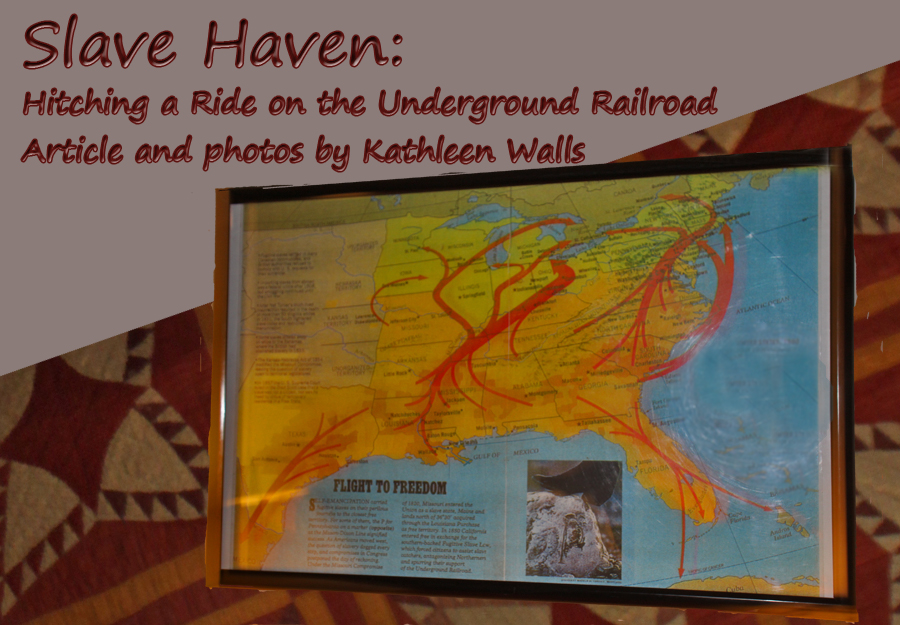
"You can't really understand another person's experience
until you've walked a mile in their shoes." There is no
way to walk in the shoes of an African Slave in the
Antebellum South or hitch a ride on the Underground
Railroad today but a visit to Slave Haven in Memphis is
as close as you can come.
 |
| The simple exterior
belies the rich heritage inside. |
|
I visited Slave Haven Underground Railroad
Museum on a recent press trip to Memphis just after I toured the
National Civil Rights Museum. For more on that museum, see
http://www.americanroads.net/civil_rights_winter2015.htm )
This was a perfect follow up.
Elaine Turner, the Museum Director
and co-owner of Heritage Tours, met us at the door and told us
the story behind the museum.
The simple white frame house was built in
1856 for Jacob Burkle, a German immigrant who owned Memphis
Stockyard. Jacob had fled an oppressive Bismarck regime in
Germany only to see oppression in his adopted country in the
form of slavery. He must have decided then and there to do
something about it.
The house was very secluded and only two
blocks from the Mississippi River.
It was a perfect location
where he could hide slaves until they could travel up the
Mississippi hidden in crates or other secret places aboard a
steamboat and then on across the Ohio River and into Canada.
The Burkle family lived in house until 1978. Family stories
passed on as oral history from Jacob to his daughter, Rebecca
Burkle Lawless, and then her daughter, Katherine Compton. Katherine Compton
lived in house until 1978 and told the family secret about her
grandfather's Underground Railroad activities. Then at
Katherine's death, her daughter, called Little Katherine, burned
all family records that might prove or disprove the story.
Still, lots of things collaborate the stories. First off, why
would someone in the south in the era lived in tell such a story
if it were not the truth. Other evidence collaborates the story.
Neighbors' oral histories tell the same stories about the
Burkles. One local Memphis resident who was tutored by Ms.
Compton recalls that she told him of her grandfather's
Underground Railroad activities.
The museum's exhibits show the entire
history of slavery from captivity in Africa and the slave
markets to the life of a slave. Memphis
was a very active slave market and the museum had many
advertisements of slave sales. Artifacts like an iron slave
collar and whips bring a vivid realism to the plight of slaves.
Elaine tells why it was forbidden to
teach a slave to read or write in most states. If a slave could
read and write they could write their own or other's
emancipation papers.
Most owners did not want to own slaves from the same African
villages to keep them from communicating. Even drums which were
a common means of communicating between villages were taken from
the slaves. So Africans developed a secret and common language,
songs. Songs like "Swing Low Sweet Chariot "contained secret
messages about the underground railroad.
Elaine translated, "‘Swing"' means run; ‘Low' means hide;
‘Chariot' is a means of
transportation. Might be a false bottomed wagon or a crate;
‘home' is the secret word for freedom; ‘Jordan' is a river.
We don't have a Jordan around but the Ohio was the river
they had to get across to freedom.
‘A band of angels'
meant abolitionists.
To the slaves the song "Wade in the Water" meant that water hid
their tracks and scent. The masters thought they were singing
about getting baptized."
 |
| Quilts on display at Slave
Haven. |
Other symbols might have been things
like a lantern in the window of an abolition's home which told
runaways it was safe to come on in. If the light was not on it
meant danger stay away. Quilts were another common message
passer. There are several old quilts at the museum and Elaine
explained some of them, "Your great grandmother would not wash
the quilt. She would air
it on the clothesline but in slave times, the pattern were
symbols that told the runaway slave many things. Different
quilts hung on a line might convey a certain messages. Such as
the wagon wheel pattern meaning be prepared to run soon or a
Cleveland Ohio Quilt pattern might mean you will cross over Lake
Erie to Canada. The
Crossroads pattern might have many meaning. Elaine told us,
"Once you cross over the crossroad into Canada, you have also
passed a crossroads in your life. You would never see your
enslaved loved ones again."
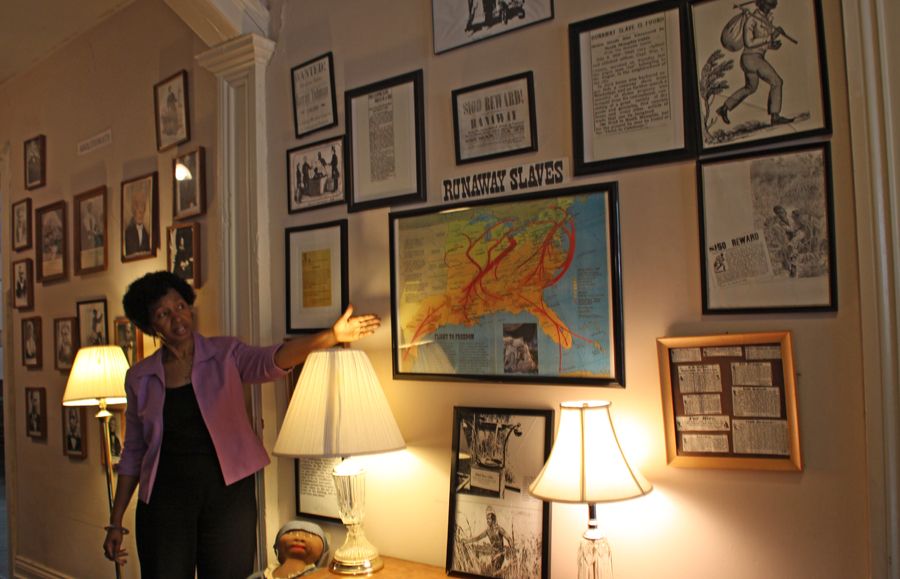 |
| Elaine explains the map of
Freedom Routes slaves would take. |
Elaine shows the map with secret routes to freedom used by
slaves. From Memphis the Mississippi river to the Ohio to Cairo
and from there up to Canada.
Once a runaway slave reached the Burkle
home, there were several clever hiding places. One secret
passage was a way to get in the cellar from what was once a side
porch. There was a trap
door discovered several years ago in the floor opening to a
crawl space leading to the cellar.
A stairway from the side porch leads to the cellar in a more
conventional way and we were allowed to descend into the dark
dreary space. There were a few spaces in the brick foundation
for air and light. What a miserable place to have to wait for a
chance to run for your very life. From inside the cellar there
is another clue to Jacob Burkle's secret.
A staircase in the celler leads up to a solid brick wall.
As Elaine asked, "who would build a staircase leading to a
wall?"
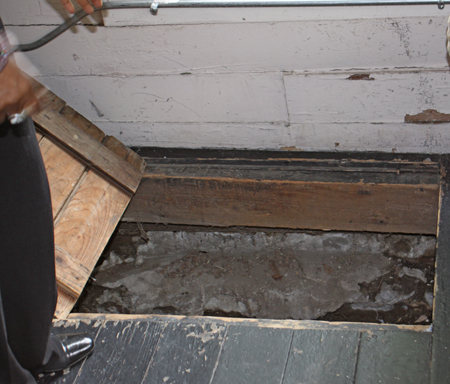 |
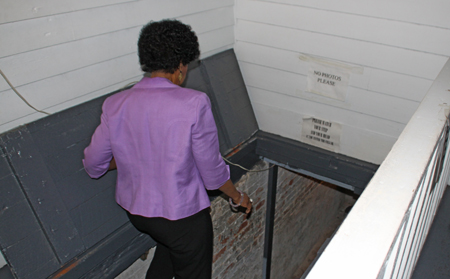 |
| The secret trap door |
Steps into the cellar |
Obviously at one time there was an opening here. It would have
led to the outside of the house and that two block run to the
river.
You walk in the shoes of
not only the runaway slaves but the abolitionist that risked
their lives to help the slaves to freedom. Jacob Burkle was not
a stupid man and he knew if his neighbors suspected what he was
doing it would mean his life. To cover his tracks, he bought two
slaves of his own. They are represented at the museum by two
mannequins in the kitchen, Aunt Liddy and an unknown man. After
he had kept them for awhile, he helped them escape. When he was
sure they were safely away, Burkle put a notice in the paper
saying he was "searching for his two runaway slaves.
How the house came to be discovered as a
stop on the Underground Railroad is a story in itself.
Mrs. Phillips bought the
house in 1985. She had no clue as to its history other than that
it had been in the Burkle family.
Dr Otis Johnson, an anthropologist, bought a house behind
hers. He did some research that led him to the discovery of the
house's past. When Mrs. Philips discovered the truth about the
home, she contacted Elaine and Heritage Tours and then created a
non-profit and donated the house to preserve the history.
Mrs. Philips was an
antique collector and purchased period antiques to furnish the
house as it would have been in Jacob's time.
Tours began in 1991.
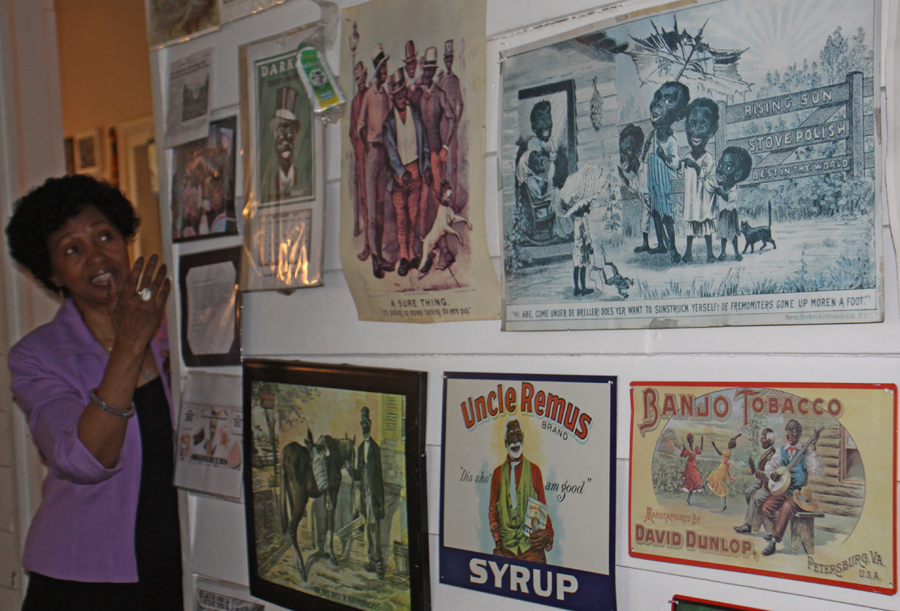 |
| Products and images used to
sterotype Africans left scars that are still present |
Obviously much is still unknown about the Underground Railroad
but one letter of thanks escaped being destroyed when "Little
Katherine" Compton burned the papers at her mother's death.
That, the oral histories and the unmistakable evidence in this
house, confirmed for me that this was once an important stop in
that secret railroad. I particularly enjoyed the museum because
I had recently finished my book, "Under a Black Flag," where one
of my former slave characters is working as a conductor on the
Underground Railroad and so much I learned here collaborated the
hard-to-find knowledge I had dug up researching the Railroad.
Elaine sums up the Underground Railroad thus, "I consider the
Underground Railroad the most successful undercover operation
that ever occurred in the United States and that includes the
FBI. They didn't have all the modern surveillance equipment but
they had a good heart."
For more info:
http://www.slavehavenundergroundrailroadmuseum.org/
|